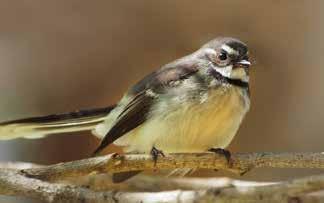
2 minute read
Nature Page
By:Marj Webber
GREY FANTAIL
Advertisement


Rhipidura Fuliginosa
Grey Fantails are common on Bribie Island and are likely to be seen anywhere in areas where there are trees. They are small, active, mainly grey birds 14-17 cm in length, half of which is tail. Their weight is only 7-10 g. They are grey above and creamy underneath with white under the chin and two white streaks above the eyes. Tail feathers are white around the edges. Fantails are named from their habit of constantly fanning their tails. They are hardly ever still and are the most restless of all Australia’s fantails twisting and turning acrobatically in the air and always waggling their tails while landed. This is thought to stir up insects to prey upon. Around their beaks are hairs that protect their eyes from angry insects when collecting their food from the air. Male and female are similar in appearance looking a little like Willy Wagtails. They are inquisitive and will often come closer to observe an approaching human. There are several forms of Grey Fantails in Australia each occupying its own specific area. The one I have described here is the one you are most likely to see on Bribie Island. Grey Fantails are found throughout Australia and can live in most habitats including rainforests, woodlands, heathlands, arid areas, parks and gardens and in fact anywhere there are trees and water. They are also found in Vanuatu, New Caledonia and the Solomon Islands. Birds in different regions in Australia can be sedentary, nomadic or migratory, each with its own system of movement. Long flights are made by Tasmanian Fantails across the Bass Strait. Insects that are captured on the wing are their main food source. These are caught above the tree canopies, among the tree foliage and in the undergrowth. Breeding usually takes place from August to December. Nests of grass, bark and cobwebs are lined with soft feathers are built by both parents on horizontal forks 1-7 m above ground. These are in the shape of wine glasses with stems but no bases. Tails are added to the base of the nest which are thought to aid run-off water during rainy periods. Clutches of 2-4 spotted pale buff eggs are laid and incubated for 14-15 days by both parents that also work together in tending to their young. Chicks fledge in about 12 days. After 3-4 months the young birds are fully grown. There are often several broods per season. A sad fact is that Grey Fantails do not live very long. Their mortality rate is remarkably high, and they are lucky to live to 3 years. They are monogamous for a season, but a pair will seldom share a second season as one or both birds have died. Grey Fantails are easily upset by any interference to the nest and will abandon it if it has been handled. Both parents aggressively defend their nests and females will often pretend to be injured and lure predators away from the site. Chemicals sprayed on foliage and insects can be a danger if fantails eat the poisonous insects. Their conservation status in all states is secure except in the Northern Territory where they are critically endangered.



